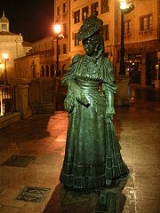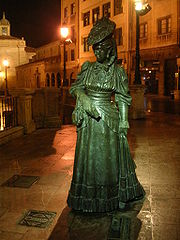
La regenta
Encyclopedia

Literary realism
Literary realism most often refers to the trend, beginning with certain works of nineteenth-century French literature and extending to late-nineteenth- and early-twentieth-century authors in various countries, towards depictions of contemporary life and society "as they were." In the spirit of...
novel
Novel
A novel is a book of long narrative in literary prose. The genre has historical roots both in the fields of the medieval and early modern romance and in the tradition of the novella. The latter supplied the present generic term in the late 18th century....
by Spanish
Spain
Spain , officially the Kingdom of Spain languages]] under the European Charter for Regional or Minority Languages. In each of these, Spain's official name is as follows:;;;;;;), is a country and member state of the European Union located in southwestern Europe on the Iberian Peninsula...
author Leopoldo Alas y Ureña
Leopoldo Alas y Ureña
Leopoldo García-Alas y Ureña , also known as Clarín, was a Asturian realist novelist born in Zamora. He died in Oviedo....
, also known as Clarín, published in 1884 and 1885.
Plot
The story is set in Vetusta (a provincial capital city, very identifiable with OviedoOviedo
Oviedo is the capital city of the Principality of Asturias in northern Spain. It is also the name of the municipality that contains the city....
, capital of Asturias
Asturias
The Principality of Asturias is an autonomous community of the Kingdom of Spain, coextensive with the former Kingdom of Asturias in the Middle Ages...
), where the main character of the work, Ana Ozores "La Regenta", marries the former prime magistrate of the city, Víctor Quintanar, a kind but fussy man much older than she. Feeling sentimentally abandoned, Ana lets herself be courted by the province casanova, Álvaro Mesía. To complete the circle, D. Fermín de Pas (Ana's confessor and canon
Canon (priest)
A canon is a priest or minister who is a member of certain bodies of the Christian clergy subject to an ecclesiastical rule ....
in the cathedral
Cathedral
A cathedral is a Christian church that contains the seat of a bishop...
of Vetusta) also falls in love with her and becomes Mesía's unmentionable rival. A great panorama of secondary characters, portrayed by Clarín with merciless irony, completes the human landscape of the novel.
Interpretation
The author uses the city of Vetusta as a symbol of vulgarity, lack of culture and hypocrisy. On the other hand, Ana incarnates the tortured ideal that perishes progressively before a hypocritical society. With these forces in tension, the AsturianAsturian people
The Asturians are one of the nationalisms of Spain, issuing from the historical country of the Principality of Asturias. They have Celtiberian heritage, related to its historical and cultural links with neighbouring Galicia, as well as Visigothic cultural influences most notably found in the...
writer narrates a cruel story of Spanish provincial life in the days of the Restoration
Spain under the Restoration
The Restoration was the name given to the period that began on December 29, 1874 after the First Spanish Republic ended with the restoration of Alfonso XII to the throne after a coup d'état by Martinez Campos, and ended on April 14, 1931 with the proclamation of the Second Spanish Republic.After...
.
Adaptations
This novel has been adapted to Film and TV, written and directed by Fernando Méndez-Leite and premiered in 1995.Also a Musical will be premiered at the Campoamor Theatre, in Oviedo, hometown of La Regenta; "La Regenta El Musical" on July 2012, writted and composed by Sigfrido Cecchini, with the stage direction of Emilio Sagi.
External links
Full text of the novel can be found here- Full text in Spanish with English translation
http://www.laregentaelmusical.com/
http://sigfridocecchini.com/Sigfrido_Cecchini.html
La Regenta is considered one of the most important Spanish novels of all time.

